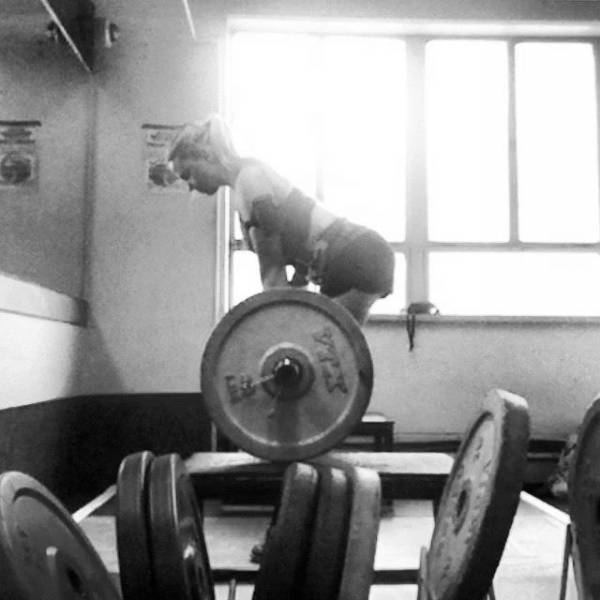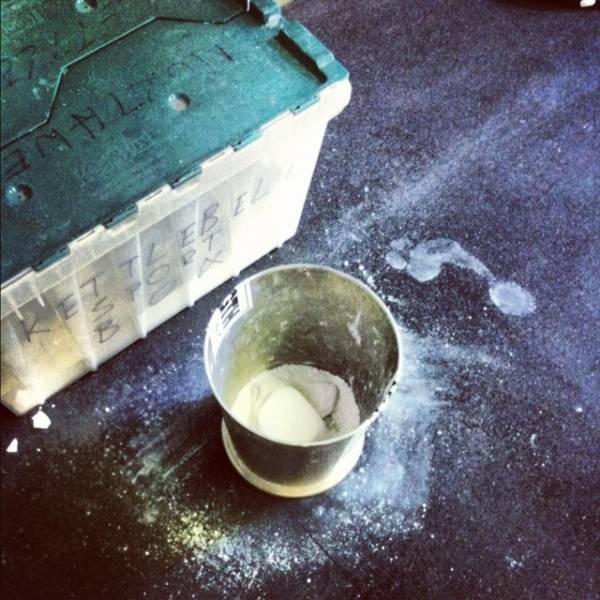Whether you’re an Olympic lifter, a CrossFitter, or any other type of athlete training the Olympic lifts, there are some important rules you need to obey when stepping on the platform:
Rule #1: Never touch the bar with your foot. Ever.
I actually make my athletes sign off on it as a part of their athlete contract when they join the RXBound Training Team. Touching the bar with your foot is a sign of disrespect for the sport of weightlifting and thus a big “no-no” on the weightlifting platform. Any lifter who sees it happen will cringe – and should.
Coach’s Note: It is okay to move or guide the bar with the shins as needed but more proper, hands are best.
Rule #2: Never step over the bar.
To swap out discs (plates) or to leave the platform, walk around the bar. Do not straddle the bar to take off weight. When you begin and when you finish with your lift, walk off the platform to the sides, never walking forward or backwards over or across the bar. This too falls into the respect category as in Rule #1.
Coach’s Note: Pull weights off from the sides of the barbell with both hands and maintaining a tight low back, just like you use to lift the barbell.
 Rule #3: Dress to address.
Rule #3: Dress to address.
Wear proper weightlifting shoes and clothing. Even though you may not be competing, it is important to address the bar as you dress for the sport. Clothes should always be close-fitting, collar-less, and should not cover up the elbows or the knees. Tennis shoes, flip-flops, or barefeet should never step foot on the platform but rather lifters should always wear Olympic weightlifting shoes. (See also my article on weightlifting straps.) Dress for the sport for which you are there to train – head to toe.
Coach’s Note: Attire rules are especially true (and are real rules) in competition so if you train to compete, you might as well train dressed like you are going to compete.
Rule #4: Head and shoulders, knees, and…hands.
Touching the platform with any part of the body other than the feet is never permitted. In other words, the platform is not the place to do your push-ups or sit-ups for example.
Coach’s Note: If you are doing a workout that requires lifting and any other movements, move the bar off the platform and do the workout there. Another option is to simply move from the platform where you are lifting to another allocated space for the other work.
Rule #5: Load it up.
 It is very important to load your barbell properly. The barbell should always be loaded in progression of lowest weight on the outside to the heaviest weight on the inside (closest to lifter). In other words, the heaviest discs go on the bar first and follow outwards in descending order. Being lazy about loading your bar is no excuse. Don’t be lazy. Take all the plates off if need be and re-load starting with the heaviest of your discs first.
It is very important to load your barbell properly. The barbell should always be loaded in progression of lowest weight on the outside to the heaviest weight on the inside (closest to lifter). In other words, the heaviest discs go on the bar first and follow outwards in descending order. Being lazy about loading your bar is no excuse. Don’t be lazy. Take all the plates off if need be and re-load starting with the heaviest of your discs first.
Coach’s Note: Another good rule of thumb is that the minimum progression weight after a “good” lift is 2.5kg, so it is helpful to plan your stack accordingly. Additionally,this kind of barbell loading is helpful for us coaches as well as judges. Loading in such a way, we can read the weight on the plates when watching or conducting video analysis.
Rule #6: Avoid heavy metal.
Metal plates that weigh more than 10kg can damage or even completely destroy the barbell and the platform by bending bars and causing friction on the spin of the bar (the spin is perhaps the biggest aspect of a good bar). In addition, metal falling on a platform can destroy even the most well built platforms. Metal plates also do not fit together due to small gaps (unlike bumper plates used on the platform which all are 18 inches).
Coach’s Note: Respect each kind and type of bar and the types of plates for which they are designed. Use each one with its accompanying pair. I have seen far too many good weightlifting barbells completely destroyed by athletes dropping them when recklessly loaded with metal.
Rule #7: Say no to the unhealthy rebound.
 Drop the bar once and do not rebound it off the ground any more than that. Save the up and down stuff (typically “for time”) for the mats or turf, or any other materials except the platform. The sport of weightlifting was and is designed to move a heavy-ass weight one time and to do so efficiently. Or at least, each repetition is separate. The bar is dropped to complete the movement and the lifter resets before the next. Drops from the top are mandatory for safety and therefore expected. The platform and the discs (plates) are both designed to accommodate the impact.
Drop the bar once and do not rebound it off the ground any more than that. Save the up and down stuff (typically “for time”) for the mats or turf, or any other materials except the platform. The sport of weightlifting was and is designed to move a heavy-ass weight one time and to do so efficiently. Or at least, each repetition is separate. The bar is dropped to complete the movement and the lifter resets before the next. Drops from the top are mandatory for safety and therefore expected. The platform and the discs (plates) are both designed to accommodate the impact.
Coach’s Note: If you are training with others or doing a variety of different lifting or strength work, do your Olympic-style weightlifting on the platform (the clean and jerk and the snatch and a few training elements of them both). Otherwise use the correct area (take it from the squat rack, off rubber mats, etc.).
Rule #8: Say what?!
 The word “lift” only refers to the two (and there are only two) lifts in Olympic weightlifting, the clean and jerk and the snatch. Anything and everything else is a modification. A clean includes the squat element (in the catch position) and therefore it does not need further explanation such as “squat clean.” Any modification of the clean is an add-to or add-on word as a modification (such as “hang clean”) and if, for example, there is no squat required, we simply add the word “power.” The same rules apply to the snatch. There is no need to add the word “squat” as a snatch always includes one. A “power snatch” does not include a squat.
The word “lift” only refers to the two (and there are only two) lifts in Olympic weightlifting, the clean and jerk and the snatch. Anything and everything else is a modification. A clean includes the squat element (in the catch position) and therefore it does not need further explanation such as “squat clean.” Any modification of the clean is an add-to or add-on word as a modification (such as “hang clean”) and if, for example, there is no squat required, we simply add the word “power.” The same rules apply to the snatch. There is no need to add the word “squat” as a snatch always includes one. A “power snatch” does not include a squat.
Coach’s Note: There are hundreds of modifications of the two lifts that are useful for training and progression (most don’t realize just how many there are). I just want to encourage making it a habit to at least be aware of the proper terminology. I understand that there are different fields of sport that include weightlifting among them and that these terms have been adjusted for the general public, but the proper terms should be used.
Rule #9: Chalk it up, but not into pieces.
 No matter how hard we may try not to do it, chalk will crumble. This does not mean that it is okay to attack the chalk bucket and break it all up and rub it all over. Use these powdery leftovers too but only when these are all the pieces you have left. The best way to use chalk is to paint it on with full or partially full block pieces. The more whole or intact the block is, the easier it is to use.
No matter how hard we may try not to do it, chalk will crumble. This does not mean that it is okay to attack the chalk bucket and break it all up and rub it all over. Use these powdery leftovers too but only when these are all the pieces you have left. The best way to use chalk is to paint it on with full or partially full block pieces. The more whole or intact the block is, the easier it is to use.
Coach’s Note: A compromise for those who prefer the chalky powder to fuller blocks is to split the full bock in half and to crumble up one half of it and save the other. This way there are both options and no one is tempted to crumble up the larger piece as the powder is there and available also.
Rule #10: There will be no bar left behind.
If you can “clean” it, you can clean it up. One of the biggest (and most frustrating) things for coaches and athletes alike is coming in to train and finding bars still loaded and no one to be found. It is wasted time and energy (both of which we should be using lifting our own weight) spent cleaning up after everyone else.
Coach’s Note: Do not leave a loaded barbell on the platform. Ever. In fact, don’t leave anything on the platform – plates, bars, chalk, bags, straps, belts, trash, water bottles, etc.
Photographs courtesy of Katie Chasey.






